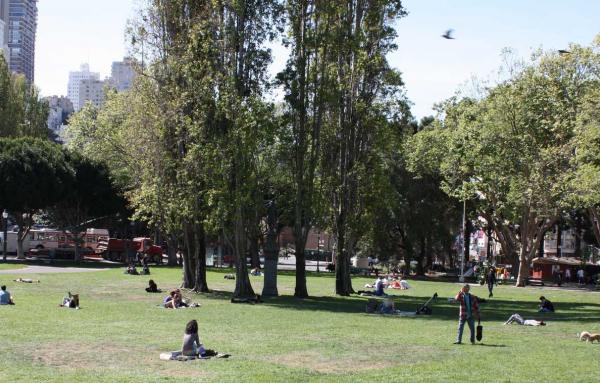
Ten environmental benefits of walkable places
“The recovery of spawl to vibrant places is literally our generation’s greatest challenge,” says architect Steve Mouzon.
There are many benefits to building walkable places, backed up by research and common sense. A research report called Cities Alive by Arup, a multinational engineering and design firm, enumerated 50 advantages of walkable places. This article, the third in a series, is based on that report and focuses on environmental benefits. Topping the list are two that relate to carbon emissions and climate.
Compact urban places are essential tools in designing for a changing climate, one of the biggest public challenges of this century. And, the environmental advantages go well beyond greenhouse gases to address other pollutants, noise, water, land use, and more. Here’s 10 environmental benefits of designing and building human-scale cities and towns:
- Reduces greenhouse gas emissions
A walkable environment reduces greenhouse gas emissions by 4 tons a year, compared to living in an automobile-dependent suburb. As Farhad Manjoo explains in The New York Times, the nation needs more than a conversion to electric vehicles (EVs). Promoting EVs does little to improve fuel efficiency without a simultaneous shift in development patterns to walkable, mixed-use neighborhoods, he explains. “Policy changes that reduce the amount Americans drive could lead to far greater efficiency gains than we’d get just from switching from gas to batteries,” notes Manjoo. - Improves urban microclimates
While paved roads contribute to the urban heat island effect—making cities hotter—shaded, plant-lined sidewalks can help cool neighborhoods down substantially. Plus, changing asphalt and roofs to lighter colors reflects up to 80 percent of sunlight, significantly reducing temperatures and the need for air conditioning in cities. This climate action can be done in a much shorter timeframe with quicker payoffs than overall reductions in carbon, helping to buy humans time in the battle against climate change. - Minimizes land use
Walking infrastructure and pedestrian-oriented spaces are comparatively more compact than motor vehicle infrastructure, requiring fewer materials and reduced construction impacts to the environment, according to Cities Alive. Suburban sprawl claims more than two million acres of undeveloped land a year, the report notes. - Reduces air pollution
Just as carbon emissions decline with fewer vehicles miles driven, so do airborne pollutants that impact health. On a single car-free day in 2015, Paris cut smog by 40 percent in parts of the city.When walkable environments incorporate more trees and vegetation, they will inherently clean the air—17 trees can absorb enough CO2 annually to offset 26,000 miles of driving. - Improves water management
Increasing the area of permeable surface and implementing green infrastructure such as bioswales keeps water out of sewer systems and removes stormwater runoff from the roads. Light imprint, an idea developed by new urbanists, is a way to affordably incorporate better stormwater performance into walkable neighborhoods. The City of Indianapolis implemented the Cultural Trail, an eight mile greenway, that diverts nearly 5 million gallons of water runoff per year, Cities Alive reports. - Promotes alternative transportation
Compact, mixed-use environments promote virtuous cycles in transportation, getting people out of cars into transit, cycling, bike-sharing, and other modes of travel. Commuters taking a subway or bus to work have to get there from their home—and a better walk makes it more likely that they’ll want to use public transit instead of driving. “As per public transit schemes, bike and car share trips start and end on foot. Thus, walkability is a key factor for solving the first/last mile problem of commuting,” notes Cities Alive. - Makes cities more beautiful
Roads and sidewalks typically take up the majority of public space in cities; in Chicago, for example, they make up 70 percent. A more walkable built environment improves the quality of this public space for everybody. The beauty of the public realm has numerous virtuous cycles, including bringing more businesses and people into mixed-use walkable places. - Increases active use of space
In walkable neighborhoods, people are also more likely to make use of parks and public squares, and other outdoor spaces. “For instance, the number of people taking part in outdoor ... activities in Copenhagen increased by more than three times in less than 30 years thanks to improvements that doubled pedestrian movements,” according to Cities Alive. - Cuts ambient noise
Walkable neighborhoods can be very quiet, especially on the less-traveled residential streets. This comes with fewer people driving at slower speeds. The sound of traffic is related to the kinetic energy of the vehicles and the sound of the tires on asphalt. Kinetic energy is the square of the speed and the weight, so it rises very rapidly at higher speeds. Plants and trees—which make streets more walkable—also reduce ambient noise. - It makes better use of space
Streets that are redesigned to become more walkable tends to create space for bike lanes, parklets, wider sidewalks, and public events. In New York, one study found 700 miles of underused public space under elevated structures.
To find out more on these and other advantages of walkable cities and towns, follow the links in the article or read the report, Cities Alive: Towards a Walking World. There are references to studies not linked above.Read also the first two articles in this four part series, Ten social benefits of walkable places, and Ten economic benefits of walkable places.







